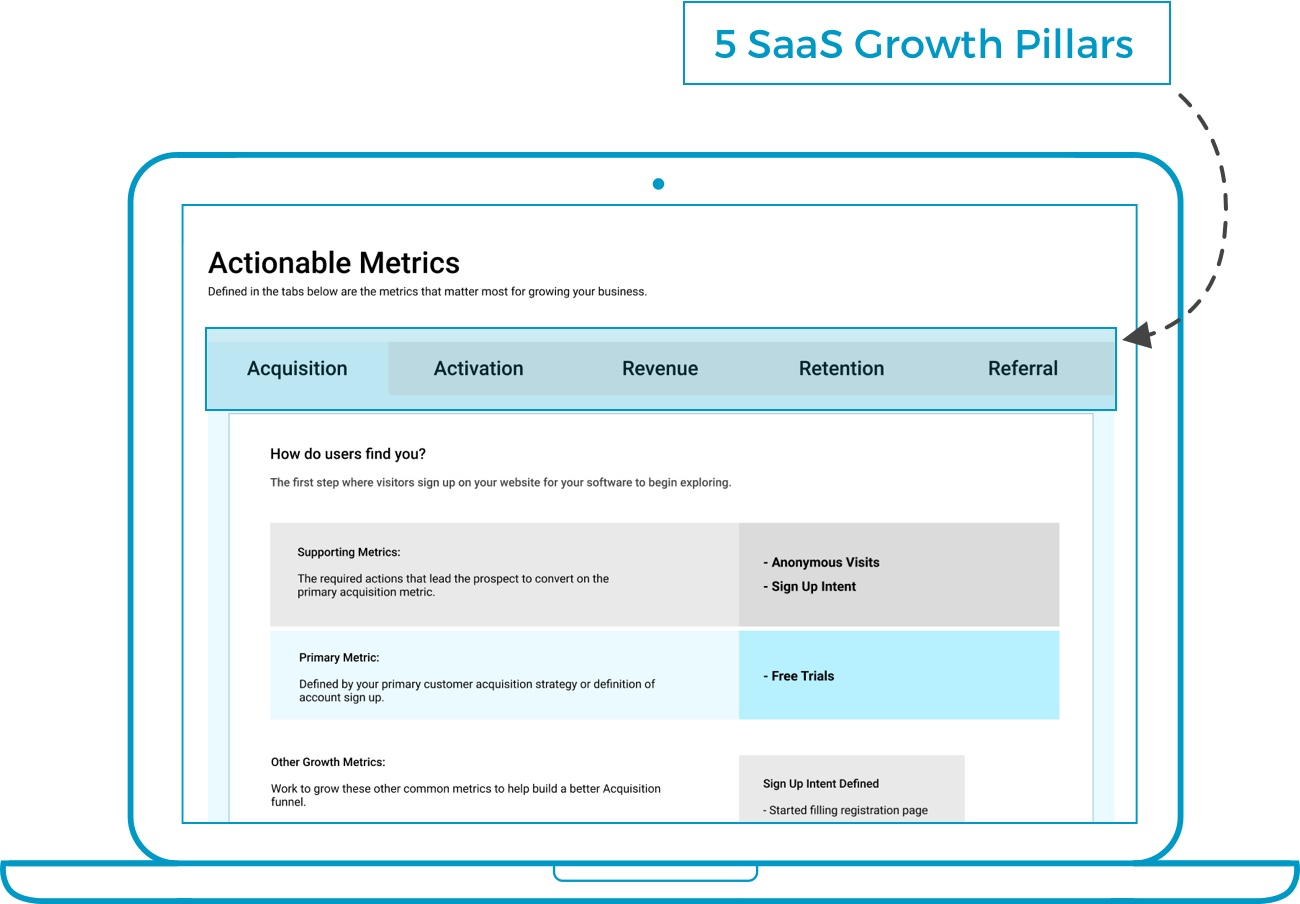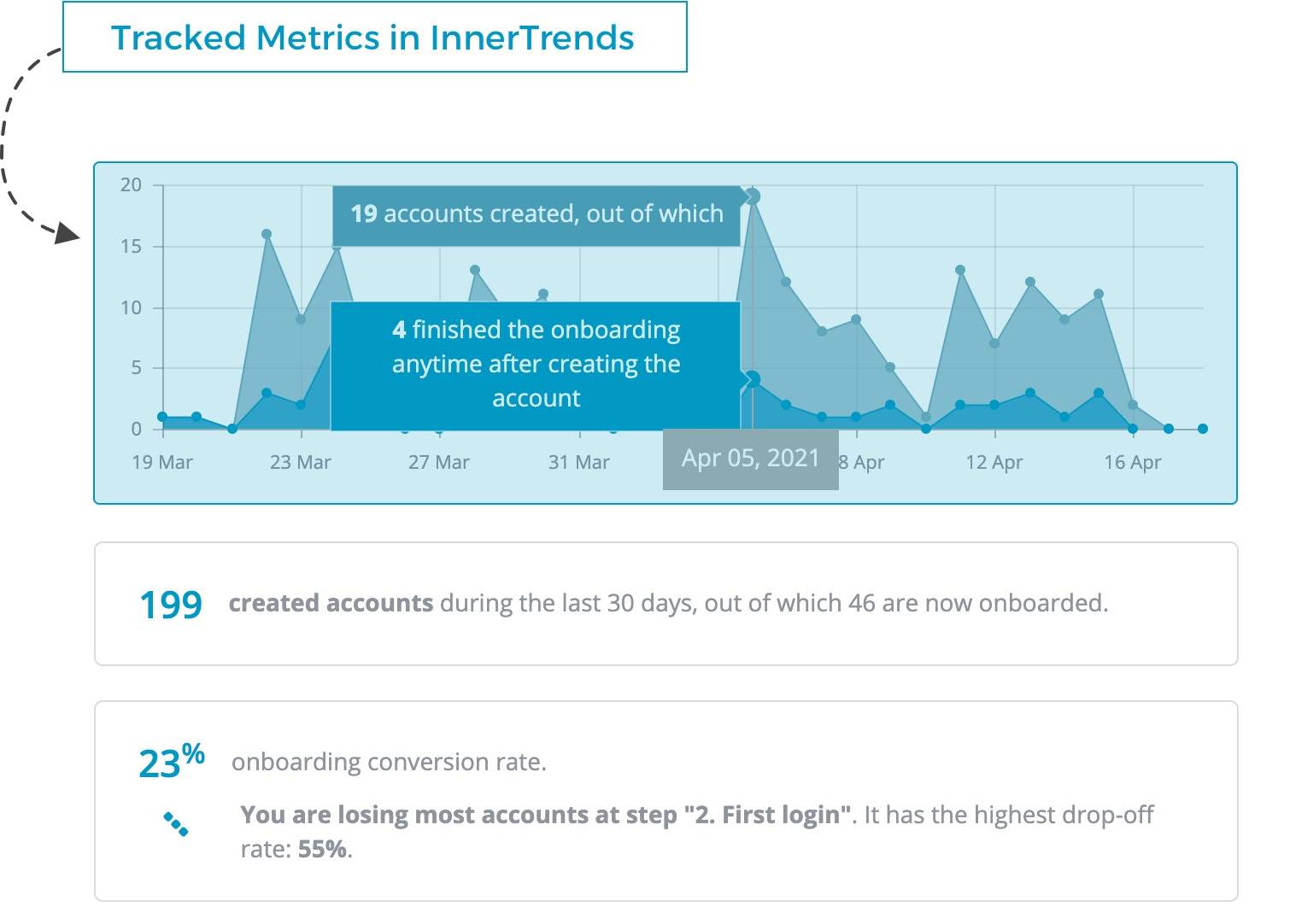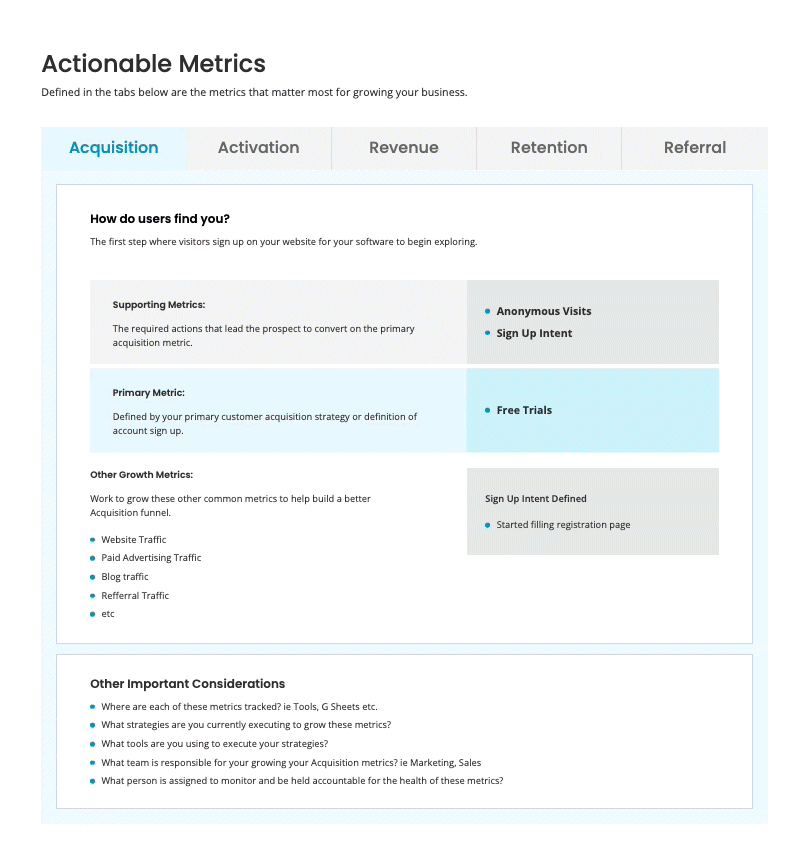For SaaS businesses, team alignment is everything.
A report by Forrester Research supports this by concluding that businesses with proper alignment see a 32% increase in revenue growth, while organizations with less alignment actually see a 7% decrease. They also concluded that only 8% of companies say their marketing and sales teams are aligned.
When your teams are aligned, you’re all moving towards common goals, and as a result, are much more likely to meet them. You may be wondering though, what does great team alignment look like and how should you go about achieving it?
Below we’ll explore the 7 steps companies need to take to align their teams for better results. Let’s get started.
1. Define The Metrics that Matter Most For Growth
The first step you’ll want to do is define the metrics that matter most for growing your SaaS business.
This step usually takes a long time to do and is hard to get right, but fear not, because we’ve built a free tool that streamlines this process and makes sure you get it right the first time.
The tool is called “The Actionable Metrics Wizard” and is designed to help you identify and define the most important metrics of a software product. The Wizard will ask you a few questions that will take around 10-15 minutes to answer.
Once you finish answering the questions, the Wizard will generate what we call an Actionable Metrics Canvas. This canvas will highlight the metrics that matter most for growing your software business and also organize them into the 5 SaaS Growth Pillars.

For those that are unfamiliar with this framework, here is a quick summary of the 5 SaaS Growth Pillars:
-
Acquisition:
- How do users find you? – The first step where visitors sign up to begin exploring your software product.
-
Activation:
- Do users have a great first experience? – When users start to use your product, we want to make sure we help them experience the value of the software quickly.
-
Retention:
- Do users come back? – This is when users keep coming back to your tool and logging in, a great indicator that they are considering buying the product.
-
Revenue:
- How do you make money? – This is when users become paying customers of your product.
-
Referral:
- Do users tell others about your product? – When users start loving your product so much, they start sharing it with their network of friends, colleagues, and co-workers.
Want to learn more about the 5 SaaS Growth Pillars? Check out this article.
So to do this step all you have to do is answer a few questions, and our tool will lay out all the information you need neatly in an Actionable Metrics Canvas for you.
Now, once you have your canvas built and the metrics that matter most for the business defined, you’ll want your entire team to discuss and agree on these. It’s crucial that your entire team is on board with what the primary metrics to focus on are when trying to grow the business.
2. Know Your Traditional SaaS metrics and Their Healthy Ranges
Your team has now agreed on the primary metrics to focus on for growth, the next step involves looking into the more traditional SaaS metrics that help you make sure your business is healthy.
Here are some of the more general metrics that apply to most SaaS products and help gauge how healthy the business is:
- Customer Churn
- Revenue Churn
- Customer Lifetime Value (LTV or CLV)
- Customer Acquisition Cost (CAC)
- Months to Recover CAC
- CAC:LTV Ratio
- Customer Engagement Score
- Qualified Marketing Traffic
- Leads by Lifecycle Stage
- Lead-to-Customer Rate
- Customer Health Score
- Net Promoter scores (NPS)
If you want to learn more about traditional SaaS Metrics we recommend reading this article by HubSpot.
Once you have extracted your traditional SaaS metrics, you then want to know if they fall under healthy ranges. For instance, you might look at your CAC:LTV ratio and define its healthy range to be that your LTV is 3 times your CAC. With a range defined, you can then compare it to your measured CAC:LTV ratio and see if it falls under that healthy range.
Doing this with the traditional SaaS metrics that are most relevant to your SaaS will give you a better understanding of how healthy your business is.
Organize these traditional SaaS metrics within each of the 5 growth pillars and you’ll have a structure in place that helps your team be on the same page with regards to the current health of your business.
3. Define Where All of Your Metrics Are Tracked
We can take these same five growth pillars and go one step further down team alignment by asking ourselves, where are these metrics tracked?
So, where are your acquisition metrics currently being tracked? Maybe they can be found within Google Analytics.
What about your activation or retention metrics? Are they being tracked within InnerTrends, Mixpanel, or Amplitude?

The same thing goes for your revenue and referral metrics. Maybe you’re using a billing system like Stripe or Chargebee to track revenue and some sort of referral tool, like a FirstPromoter, to track your referral metrics.
The point is that your entire team needs to understand where these metrics are being tracked, in a very simple form, without some sort of complex wireframe.
If you don’t make it easy for your team to be able to look at the metrics of your business then they won’t bother looking at them; this step is all about making all of your metrics easy to access for your team.
This becomes really helpful for any team member since they will be able to quickly find the current status of any metric at any given time.
4. Define The Growth Strategies You’ll Want to Execute
The next step involves aligning your team around what are the growth strategies being executed to improve the primary metrics of your business.
Once again we will look into each of the 5 Growth Pillars and start looking at the strategies your team will want to use to grow each pillar. This way your team will understand what is being done to ultimately grow the business.
So for example, ask yourself what sort of strategies would you deploy to grow your Sign-ups? Or what sort of strategy are you using to increase your onboarding rate?
Maybe you need to increase user engagement levels, customer lifetime value, or customer acquisition costs. The point is, that you need to start defining for each of your primary metrics and the strategies for growing them. That way your team understands and is aligned around the strategies currently being deployed to grow the business.
5. Define the Tools Needed to Execute the Growth Strategies
Usually, to execute your growth strategies you will need to use a specific tool, so you need to define what tools are needed to execute the strategies you’re planning to use.
This will help you identify within each of the five growth pillars, which tools you have, and which tools you may be lacking within your growth stack to execute those strategies.
You’ll be able to easily find gaps within your growth stack, and your teams will have everything they need to execute those strategies.
6. Assign Team Responsibility
Now, once you have all these defined, in order to really align the team, you should look at assigning responsibility.
Take a look at the strategies you defined for each of the 5 Growth Pillars in step 4, now think of what team will be responsible for executing each strategy.
For example, acquisition strategies normally fall under the sales and marketing teams, activation and retention strategies are usually handled by your product team or your customer success team.
The point is that you need to define and agree on what teams are responsible for executing what strategy.
The responsibility of growing a metric will drive your teams towards generating results.
7. Assign Individual Responsibility for Monitoring Metrics
We highly recommend taking responsibility a step further by assigning individual responsibility for monitoring metrics. To be clear, the individual isn’t responsible for growing that metric alone, they’re responsible for understanding that metric and reporting it to the rest of the team.
So in order to do that, one of the things you would want to do is create a scorecard, set baselines for each metric, and then determine a goal the team will want to strive for.
The individuals responsible for monitoring the metric will report the performance of the metric assigned to them at team meetings. Whether that’s on a week-to-week basis, bi-weekly, monthly, or whatever type of cadence, will depend on what fits best with your business.
Now during your team meetings, you’ll be able to go down the scorecard and see how each metric is performing. You’ll be able to constantly gauge if you’re hitting your targets or not, and if not, you’ll be able to start team discussions on how to improve results.
This constantly gives your entire team a clear picture of how the business is performing and the actions needed to grow the business.
In Conclusion
Ultimately, there are seven steps you need to take to align your team and get better results:
- Define the metrics that matter most for the growth of your SaaS business
- Gauge the current health of the business through more traditional SaaS metrics
- Document for your team where all the metrics are currently being tracked
- Agree upon the growth strategies you will want to execute and clearly define them
- Define the tools needed to execute the growth strategies decided on the previous step
- Assign team responsibility for growing each metric
- Assign individual responsibility for monitoring each metric.
If you follow these steps your company will be able to get better results by aligning your team across the board.
What are you waiting for? Get started on aligning your team for better results by building your Actionable Metrics Canvas!

